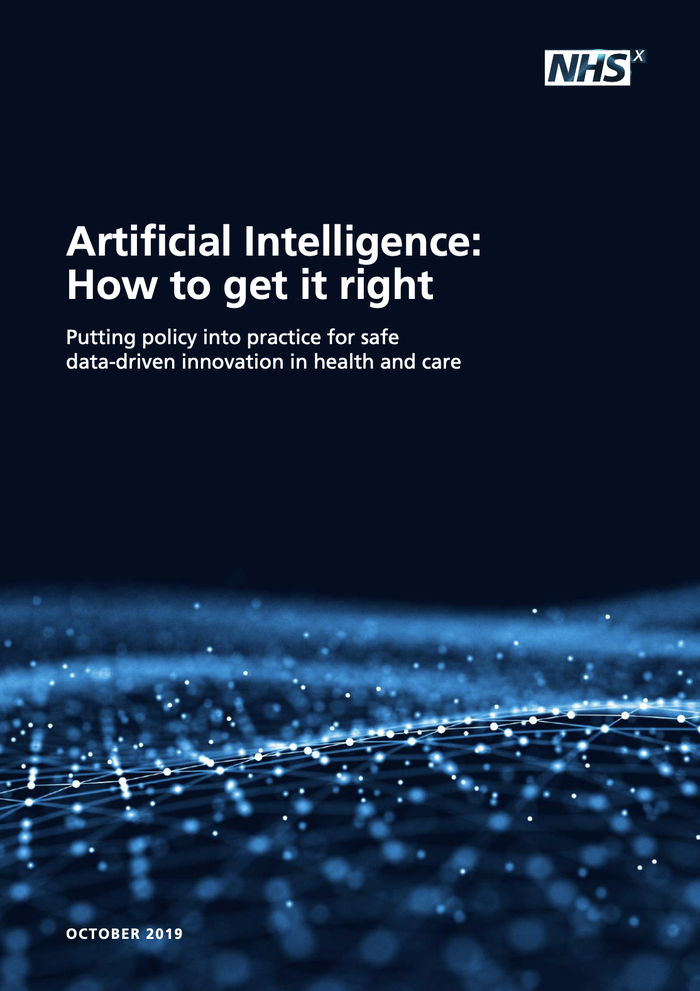This summary gives an overview of the AI challenges and opportunities covered in the NHS AI Lab 2019 Report - Artificial intelligence: how to get it right which looks at data-driven technologies in the health and care system, from the local research environment to international frameworks in development.
How to get it right, sets out the foundational policy work that was done to develop the plans for the NHS AI Lab. It outlines where in the system AI technologies can be used and the policy work that is, and will need to be done, to ensure the use of AI is safe, effective and ethical.
- Overview
- Introduction
- Developing the governance framework
- Clarifying data access and protection
- Encouraging ‘Good’ innovation & monitoring impact
- Creating the workforce of the future
- Developing international best practice
- Conclusion
Introduction
This gives an overview of:
- what AI is (and importantly is not)
- why it’s important
- a detailed look at what is currently being developed
It evaluates the results of a horizon scanning exercise and our second ‘State of the Nation’ survey. This analysis shows that diagnosis and screening are the most common uses of AI, identifying 132 different AI products being designed for diagnosis or screening covering 70 different conditions.
Developing the governance framework
This chapter provides an in-depth look at the governance of AI. Building on the Guide to Good Practice for data-driven health and care technology, it considers legislative regulation on what could or could not be developed and the development of a novel governance framework for softer ethical considerations of whether specific AI solutions “should vs should not” be developed. It covers key areas such as the:
- explainability of an algorithm
- evidence generation for efficacy of fixed algorithms
- importance of patient safety
- what commercial strategies to consider
Clarifying data access and protection
Information Governance (IG) is a topic that’s guaranteed to come up when talking about AI to innovators, regulators, commissioners and citizens.
IG is crucial because protecting patient data is of the utmost importance, but IG should not be seen as a blocker to using data that can deliver genuine benefits to patients, clinicians and the system. This chapter highlights how we are working on IG collaboratively with key partners across the system to clarify the rules of IG and streamline access to data through programmes such as the Digital Innovation Hub.
Encouraging ‘Good’ innovation & monitoring impact
The complexity of the NHS can sometimes have a negative effect on the spread of important innovation. This chapter covers action being taken to encourage adoption of innovative solutions.
Given the challenges involved in the practical implementation of AI, we don’t want to encourage adoption for adoption’s sake. This chapter, therefore, also covers ‘what good looks like’ and how we can monitor the impact of the introduction of AI over time so that good stays good as AI products make their way into the system.
Creating the workforce of the future
Building on the work of Health Education England and the Topol Review, this chapter highlights the challenges faced by the workforce developing, deploying and using AI. It looks at what needs to be done to ensure the workforce have the skills they need to feel confident using AI safely and effectively in clinical practice.
Developing international best practice
AI technologies are not only trained and tested on data generated in England. The AI ecosystem is international and we need international collaboration and agreement of standards, frameworks and guidance. This chapter highlights the ongoing work of the Global Digital Health Partnership, the World Health Organisation and the EQUATOR network in developing standards and guidance.
Conclusion
This brings together all the information included in the previous chapters to highlight why we knew that the Lab was needed and why it will be crucial in helping us achieve our aims of:
- promoting the UK as the best place in the world to invest in healthtech
- providing evidence of what good practice looks like to industry and commissioners
- reassuring the public, patients and clinicians that data-driven technology is safe, effective and protects privacy
- allowing government to guide suppliers on the development of new technology so products are suitable for the health and care system now and in the future
- building in-house expertise to prototype and develop ideas
- making sure the NHS gets a fair deal from the commercial use of its data resources and expertise

